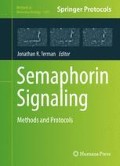Abstract
Neurons can endocytose soluble semaphorins to either initiate or interrupt signaling at the cell membrane. Depending on the cell type and even on the specific subcellular domain, the endocytic process will differ in intensity, speed, and modality, and will subsequently facilitate diverse actions of semaphorin molecules. Therefore, in order to understand the physiology of guidance cues like semaphorins it is important to visualize endocytic events with good spatial and temporal resolution. Here, we describe methods to visualize endocytosed Semaphorin3A (Sema3A) molecules and to characterize the rate and pathway of internalization in primary rat neuronal cultures using semiconductor quantum dot nanoparticles (Q-dots).
Access this chapter
Tax calculation will be finalised at checkout
Purchases are for personal use only
References
Carcea I, Ma’ayan A, Mesias R et al (2010) Flotillin-mediated endocytic events dictate cell type-specific responses to semaphorin 3A. J Neurosci 30(45):15317–15329, doi:30/45/15317 [pii]10.1523/JNEUROSCI.1821-10.2010
Dang P, Smythe E, Furley AJ (2012) TAG1 regulates the endocytic trafficking and signaling of the semaphorin3A receptor complex. J Neurosci 32(30):10370–10382. doi:10.1523/JNEUROSCI.5874-11.2012
Tojima T, Itofusa R, Kamiguchi H (2010) Asymmetric clathrin-mediated endocytosis drives repulsive growth cone guidance. Neuron 66(3):370–377. doi:10.1016/j.neuron.2010.04.007
Castellani V, Falk J, Rougon G (2004) Semaphorin3A-induced receptor endocytosis during axon guidance responses is mediated by L1 CAM. Mol Cell Neurosci 26(1):89–100
Piper M, Salih S, Weinl C et al (2005) Endocytosis-dependent desensitization and protein synthesis-dependent resensitization in retinal growth cone adaptation. Nat Neurosci 8(2):179–186. doi:10.1038/nn1380
Takahashi T, Fournier A, Nakamura F et al (1999) Plexin-neuropilin-1 complexes form functional semaphorin-3A receptors. Cell 99(1):59–69
Yap CC, Winckler B (2012) Harnessing the power of the endosome to regulate neural development. Neuron 74(3):440–451. doi:10.1016/j.neuron.2012.04.015
Akerman ME, Chan WC, Laakkonen P et al (2002) Nanocrystal targeting in vivo. Proc Natl Acad Sci U S A 99(20):12617–12621. doi:10.1073/pnas.152463399
Zhu Y, Hong H, Xu ZP et al (2013) Quantum dot-based nanoprobes for in vivo targeted imaging. Curr Mol Med 13(10):1549–1567
Kaech S, Banker G (2006) Culturing hippocampal neurons. Nat Protoc 1(5):2406–2415, doi:nprot.2006.356[pii]10.1038/nprot.2006.356
Mintz CD, Carcea I, McNickle DG et al (2008) ERM proteins regulate growth cone responses to Sema3A. J Comp Neurol 510(4):351–366
Chen Y, Stevens B, Chang J et al (2008) NS21: re-defined and modified supplement B27 for neuronal cultures. J Neurosci Methods 171(2):239–247. doi:10.1016/j.jneumeth.2008.03.013
Schindelin J, Arganda-Carreras I, Frise E et al (2012) Fiji: an open-source platform for biological-image analysis. Nat Methods 9(7):676–682. doi:10.1038/nmeth.2019
He Z, Tessier-Lavigne M (1997) Neuropilin is a receptor for the axonal chemorepellent Semaphorin III. Cell 90(4):739–751
Kolodkin AL, Levengood DV, Rowe EG et al (1997) Neuropilin is a semaphorin III receptor. Cell 90(4):753–762
Tamagnone L, Artigiani S, Chen H et al (1999) Plexins are a large family of receptors for transmembrane, secreted, and GPI-anchored semaphorins in vertebrates. Cell 99(1):71–80, doi:S0092-8674(00)80063-X [pii]
Author information
Authors and Affiliations
Corresponding author
Editor information
Editors and Affiliations
Rights and permissions
Copyright information
© 2017 Springer Science+Business Media New York
About this protocol
Cite this protocol
Carcea, I., Benson, D.L. (2017). Visualizing and Characterizing Semaphorin Endocytic Events Using Quantum Dot-Conjugated Proteins. In: Terman, J. (eds) Semaphorin Signaling. Methods in Molecular Biology, vol 1493. Humana Press, New York, NY. https://doi.org/10.1007/978-1-4939-6448-2_20
Download citation
DOI: https://doi.org/10.1007/978-1-4939-6448-2_20
Published:
Publisher Name: Humana Press, New York, NY
Print ISBN: 978-1-4939-6446-8
Online ISBN: 978-1-4939-6448-2
eBook Packages: Springer Protocols

